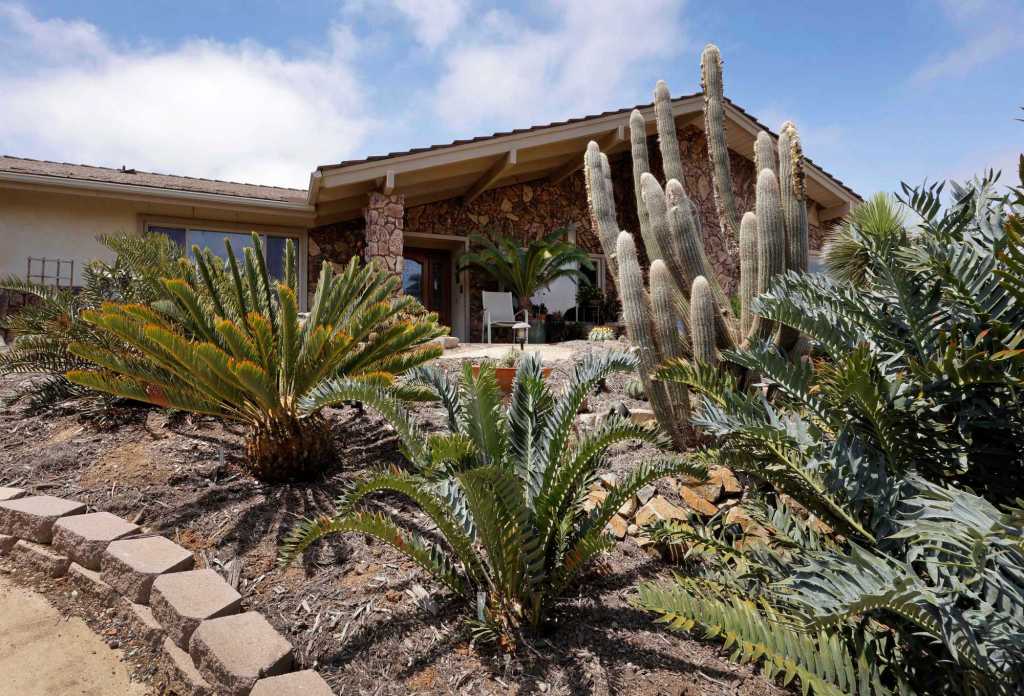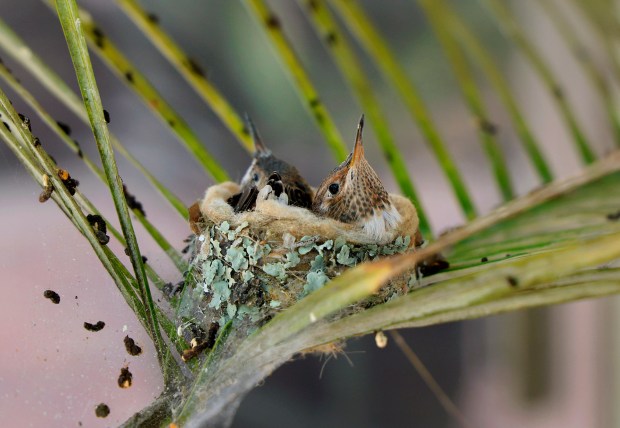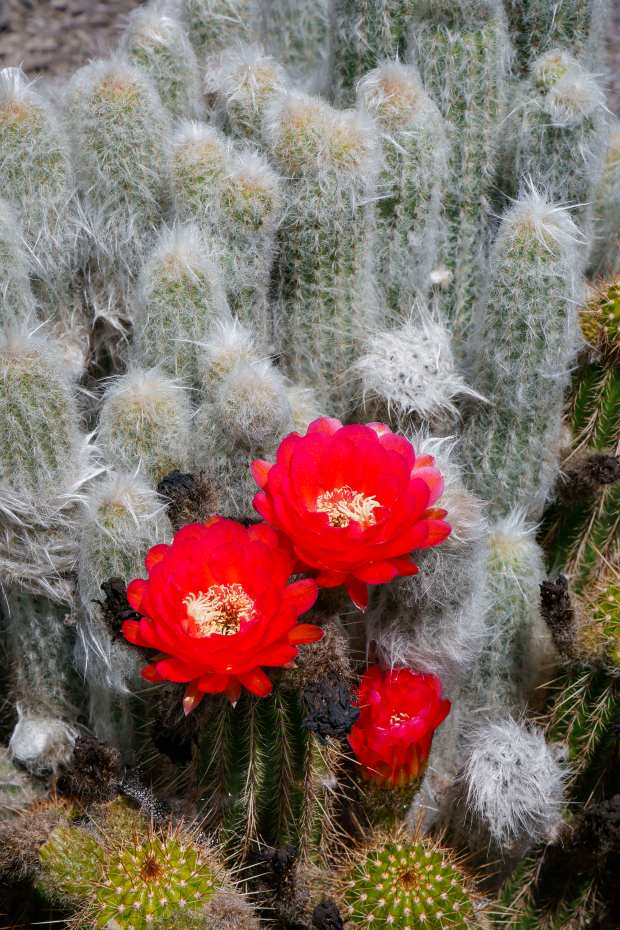For The Union-Tribune
John Allen has an addiction, and he readily admits it. He can’t live without cycads. He has planted dozens of varieties of them across his 1-acre hillside property in rural Vista. Allen bought the house back in 2007 and lives there with his partner, Bob. Almost immediately after moving in, he started to redo the landscape.
“I turned off the outside water, killed the grass lawn in front and back, had juniper shrubs, hedges and some ice plants removed, along with dying avocado trees,” he recalled. “The only two plants remaining are Beaucarnea recurvata (ponytail palms).”
And then he planted. And planted. Yes, all the various cycads, but also cacti and succulents, and citrus trees.
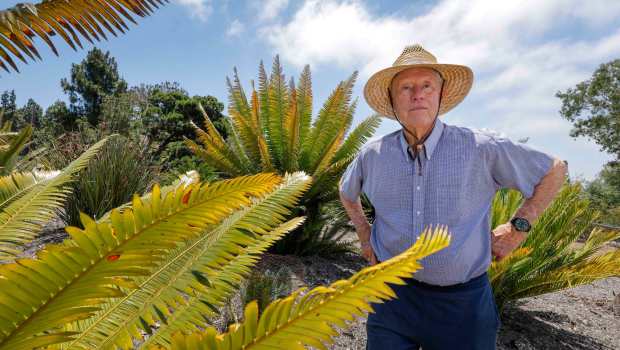 Most of the cycads that John Allen, 82, owns have come from referrals from other collectors or specialty nurseries. At left is a Dioon maejae cycad. (Charlie Neuman / For The San Diego Union-Tribune)
Most of the cycads that John Allen, 82, owns have come from referrals from other collectors or specialty nurseries. At left is a Dioon maejae cycad. (Charlie Neuman / For The San Diego Union-Tribune)
If you’re not sure about what cycads are, they are hardy, evergreen cone-bearing plants. They usually have a stout, woody trunk with a crown of large, hard, stiff evergreen fronds that can look like a palm. In fact, sago palms are cycads. They’re also dioecious, meaning a plant is either male or female. Allen pointed out that the male cones are long and slender while the females have rounder cones reminiscent of pineapples that start to open when they’re ready to be fertilized. In their native lands (Australia, South Africa, Mexico, China and Vietnam, among other places), there are insects that are doing the pollinating. Otherwise, it’s up to gardeners to gather pollen from a male cone and place the pollen into the female cones.
It took Allen, now 82 and retired since 2001 from a career as a math instructor at Saddleback College, three years to “complete” the garden. Of course, complete isn’t exactly the right word, since there is a row of small plants in their plastic containers alongside one bed waiting to be planted.
Show Caption
1 of 3
Small pineapplelike flowers bloom on a Coryphantha robustispina cactus in the garden of John Allen. (Charlie Neuman / For The San Diego Union-Tribune)
“Plants sometimes don’t thrive and need to be replaced, and sometimes I see plants I want to have,” he said. “And there’s always the maintenance of pruning dying leaves and branches.
“Gardens are never totally done, but,” he joked, “we were worn out after three years.”
And he felt it was done enough to enter the Vallecitos Water District’s WaterSmart Landscape Contest last year.
“A friend of mine who’s a cycad nut knew someone who had entered the contest in a different water district and told me about it,” Allen recalled. “And so I looked it up on the internet and sure enough, the water company here was participating so I applied and won.”
Allen’s award was a $250 gift certificate to Green Thumb Nursery, along with water bottles and a couple of gardening tools.
 Detail view of a blooming Agave Victoria-reginae compacta in . (Charlie Neuman / For The San Diego Union-Tribune)
Detail view of a blooming Agave Victoria-reginae compacta in . (Charlie Neuman / For The San Diego Union-Tribune)
The inspiration
Several years before moving down to San Diego from Laguna, Allen had been introduced to botanist Loran Whitelock, who specialized in cycads until his death in 2014. Whitelock had collected thousands of cycads, many rare, for his property in Eagle Rock, northeast of Los Angeles. Around 2000, Allen visited Whitelock’s house for the first time.
“I walked into his yard and it was just like walking into Jurassic Park,” Allen marveled. “His family, I guess, was wealthy and he worked for L.A. County, but he would hire a helicopter down in Australia to take him out in the Outback and collect seeds. He’d spend several hundred dollars just to get those few seeds. And he sold a lot of cycads. I bought a lot of cycad seedlings from him.”
Another source of inspiration for Allen was a visit he made to Lotusland in Santa Barbara. Founded by Ganna Walska, Lotusland is noted as one of the 10 best gardens in the world.
“I took a trip with a bromeliad club up there and got a guided tour,” said Allen. “That was an inspiration, too. But Whitelock was the main inspiration.”
Allen explained that Whitelock taught him and others how to pollinate plants and how to identify them.
 Some cycads are sun-loving plants; others are suited to the shade. Allen had a layered shade structure installed for these on his patio. (Charlie Neuman / For The San Diego Union-Tribune)
Some cycads are sun-loving plants; others are suited to the shade. Allen had a layered shade structure installed for these on his patio. (Charlie Neuman / For The San Diego Union-Tribune)
The details
Once Allen cleared the property, he started by mapping out his plants. On the backyard hill, for instance, he wanted to plant the dioons, cycads native to Mexico and Central America. He choose an area on the other side of the house for planting dwarf limes, oranges, lemons and tangerines. They’re actually not far from the ponytail palms, which are hundreds of times larger than the ones many of us keep as houseplants.
Allen had to consider sun exposure for the plants. Since the property completely surrounds the house, there’s sun all day, and most cycads love full sun — but for the plants that need shade, he either set them closer to the house under eaves or placed them under the shade cloths he installed.
“I laid everything out, and then, of course, I made a few minor changes here and there along the way,” he said, although he joked that even with planning, the citrus trees have grown so much larger than he thought they would.
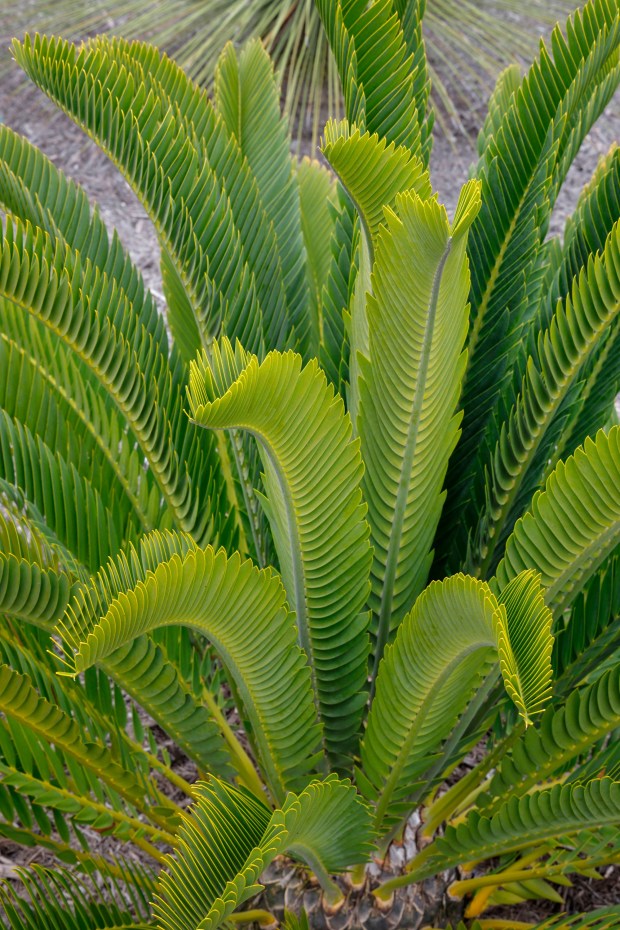 Detail view of a Sago cycad in the garden of John Allen. (Charlie Neuman / For The San Diego Union-Tribune)
Detail view of a Sago cycad in the garden of John Allen. (Charlie Neuman / For The San Diego Union-Tribune)
“I can barely walk between some of them and reach the fruit on the top,” he said.
Allen did a lot of the work himself, but he did hire local men who did garden work in the area to do some grading, dig holes and plant the hundreds of plants he had.
“I also had the back patio cover removed and had a larger area with shade cloth installed for plants needed filtered sun,” he said. “And I had a second shade cloth area installed. I added a small retaining wall extending from the original one and cut into the slops to create paths. I installed the drip irrigation, and we had most of the land covered in mulch from Agri Service’s El Corazon Compost Facility in Oceanside.”
While there is the occasional live oak or cactus — Allen has some gorgeous victoriae-reginae agaves throughout the property, for instance — the cycads truly are the point of the garden. Walking through the property is like walking through a forest of prehistoric-looking plants. Look to the ground and you can see the cones that are popping up like pups. Above, the narrow fronds look like they should be soft — and Allen said that they are when they’re just stretching out — but they are stiff and resistant to just being brushed by.
Cycads, particularly the exotic ones that Allen is interested in, are hard to find in nurseries, he said. So most of the plants Allen acquired were through referrals to other collectors or specialty nurseries. It’s not uncommon for collectors to sell seeds and plants to one another. However, Allen has frequented Clausen Nursery in Vista for the citrus trees, Anderson’s La Costa for cactus and other uncommon plants, and Green Thumb Nursery in San Marcos and Grigsby Nursery in Vista for unusual plants.
Allen doesn’t get many visitors, and it’s not a community where people just walk or drive by, so he hasn’t gotten much in the way of neighborhood comments on his landscaping. But he and Bob are happy with their creation. Even the patio off the house is filled with cycads. One of them currently is the home of a hummingbird nest with two tiny chicks growing inside.
At this point, Allen is in maintenance mode with the garden — replacing clogged drippers, planting new plants or moving others, cleaning up old and dying leaves and cones. Beyond that, it’s become a lovely retreat.
“It’s nice to sit back and relax on occasion and enjoy it,” he said.
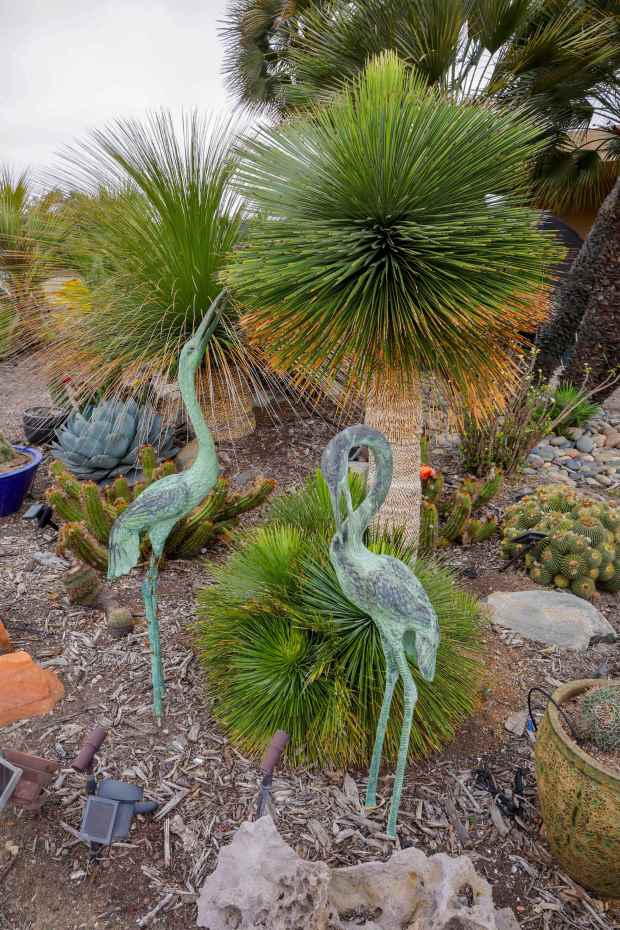 Bird sculptures stand next to Yucca Linearifolia plants near the driveway at the home of John Allen. (Charlie Neuman / For The San Diego Union-Tribune)
Bird sculptures stand next to Yucca Linearifolia plants near the driveway at the home of John Allen. (Charlie Neuman / For The San Diego Union-Tribune)
Costs
Allen said he has spent between $18,000 and $20,000 on the landscape, including the initial grading and drip irrigation, the shade structures, mulch, the retaining wall extension, and, of course, the plants.
Water saved
Since Allen took out virtually all of the plants after buying the property, he can’t say he’s saved any money on water bills. His watering is all through drip irrigation — even the pots on the patio. It runs a couple of times a week most of the year and increases to three times a week in the hottest months.
A closer look: John Allen
Plants used: mesquite (Prosopis), Bismarck palm (Mismarckia nobilis), dwarf palm (Chamaerops humilis), Mexican blue fan palm (Brahia armata), Queen Victoria agave (Agave victorea-reginae), Agave ferdinandi regis (Agave ferdinandi-regis), artichoke agave (Agave parryi), bread palms (Encephalartos: cerinus, friderici guilielmi, horridus, princeps, whitelockii, ferox, arenarius, dyerianus; sago palms (Cycas: debaoensis, hoabinesnsis, revoluta); Palma de la virgen (Dioon: merolae, califanoi, szwedowski, vovidesii, tomaselli); Strelitzia mandella (yellow form of bird of paradise), Moroccan Mound (Euphorbia resinifera), snowflake spurge (Euphorbia polygona “snowflake”), Christmas/Easter cactus (Schlumbergera), mistletoe cactus (Rhipsalis ‘Pilocarpa’), Claret cup (Echinocereus triglochidiatus), Cardon grande cactus (echinopsis terscheckii), trumpet flower cactus (tricholobivia), San Pedro cactus (trichocereus), beaked yucca (Yucca rostrata), linear leaf yucca (Yucca linearifolia), Queretaro yucca (Yucca queretaroensis); and orange, lemon, lime and tangerine trees
Estimated costs and any rebates you got: Allen estimated that he has spent $18,000 to $20,000 on the landscape, including the shade structures, retaining wall, grading, drip irrigation, mulch, and, of course, plants. He took out the lawn long before a rebate program was established.
Who did the work: Allen and his partner, and hired help
How long it took: Approximately three years
Water savings: It’s hard to state how much water was saved since virtually all of the plants that were there were removed once Allen moved in. Today, however, he pays about $200 a month.
Advice:
• Map out your landscape before planting.
• Leave space for plants to grow to their full size.
• It’s better to under-water than overwater.
• I have found that an inexpensive water meter that is inserted into the soil is a helpful tool.
About the series
This is the sixth this year in an occasional series on 2024 winners of the annual WaterSmart Landscape Contest, conducted in partnership with the San Diego County Water Authority. To learn about entering the next contest, visit landscapecontest.com.
For details on classes and resources through the WaterSmart Landscape Makeover Program, visit watersmartsd.org. Landscape rebates are available through the Socal WaterSmart Turf Replacement Program at socalwatersmart.com.
